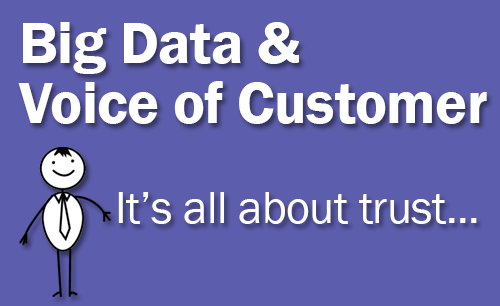Big Data and Voice of Customer – why it is all about trust

Talk of Big Data is everywhere, but it is increasingly moving beyond the hype cycle to deliver real results to businesses. To start with, let’s define what Big Data actually is, given there are multiple descriptions in the market. According to Gartner, Big Data is “high volume, high velocity, and/or high variety information assets that require new forms of processing to enable enhanced decision making, insight discovery and process optimisation”.
Top-down versus bottom-up
For those in the information management profession, the advent of Big Data means that the traditional, top-down view of the job is being turned on its head. For the best part of the last 20 years information managers have known what business information they’ve been looking for and have built the data models to try and find it. So they’ve consolidated relevant information, built the data warehouses and worked toward the all elusive single version of the truth.
But this all changes in a Big Data world. Very often information professionals don’t necessarily know what they’re looking for. Instead, as Gartner puts it, they ask the question "What would the data tell us if it could talk?”. It’s a fundamentally different, bottom-up way of looking at data and one which more traditional information managers can fear and view as a threat. They might for instance worry that the new breed of data scientist will lead to added costs and complexity through data fragmentation, or they may just fear that new technology and methods will replace the more traditional way of doing things.
The same worries also apply to customer experience professionals who have focused on Voice of the Customer’ (VoC) exercises to better understand consumers. Again, these tend to be top-down methodologies, but now Big Data techniques can be applied potentially to vast data sets to uncover different customer insights that potentially go beyond VoC.
The role of trust
Does this mean that the Big Data approach now takes over? No. At least in the short and medium term both traditional and Big Data techniques need to exist side by side. In the view of Gartner, success will come from reconciling both approaches within the same strategic framework. But they caution that the key to the success of Big Data (like any information management project) is trust.
Trust begins with the customer. They have to have faith in the ability of an organisation to keep their data safe and not misuse it. Otherwise, not only will they not provide it, but they will move elsewhere to do business with companies they do trust to protect their data.
Secondly, and equally importantly, it means having trust in the data you are analysing. This is where customer interaction data (i.e. the questions people ask via customer service channels) is incredibly valuable. This is for three reasons:
- Data is captured in real-time, when customers are actively engaged with your brand (as opposed to a survey filled in at a later date).
- It is from the coal face – participants are on the customer journey so it is real world experience – for all the good and bad that might mean.
- It provides both immediate opportunities (for instance, if customers have a problem that could point to a wider issue that needs solving in real-time) and longer term ability to analyse trends in customer behaviour.
The role of customer interaction information to Big Data
So, how should a organisation best manage this information so it contributes to their Big Data (or traditional information management) mix? There are four key points of focus to look at:
- Ensure interaction software is open and it is easy to share data in real-time with other systems.
- Make sure it includes the ability to segment by channels, to give multiple views into data.
- Natural language and linguistics are a must to provide insight into not just what is being said, but tonality and the context of how it is being said.
- Make it able to link together the whole customer journey, across channels and devices to give a holistic picture.
Despite the hype around Big Data, there is real potential (starting with the four points above) to deliver valuable insight. This doesn’t necessarily mean replacing traditional methods, but using a parallel approach, where Big Data techniques are unleashed to find nuggets of information that organisations never thought to look for up to now. Customer interaction data should be central to both traditional and Big Data efforts as it delivers the true Voice of the Customer, while they are on their journey. Organisations therefore need to ensure they are integrating it into their information management efforts and mining it for the information they need to better understand customers and deliver what they want.







Comments